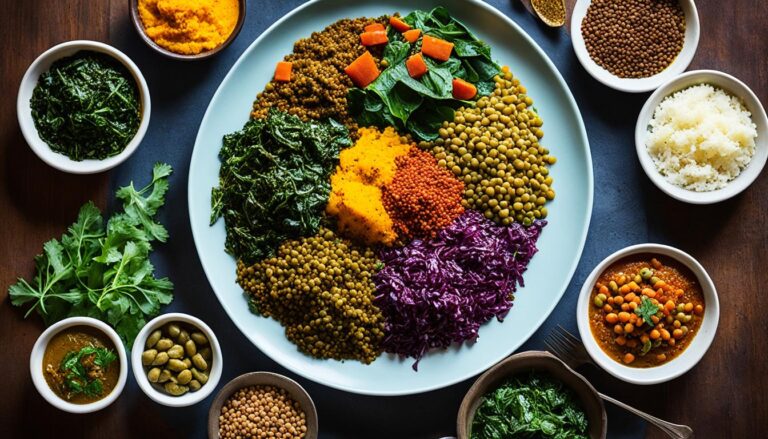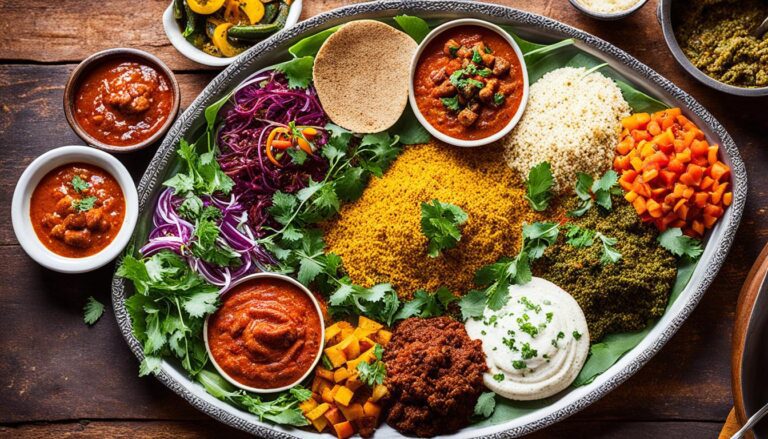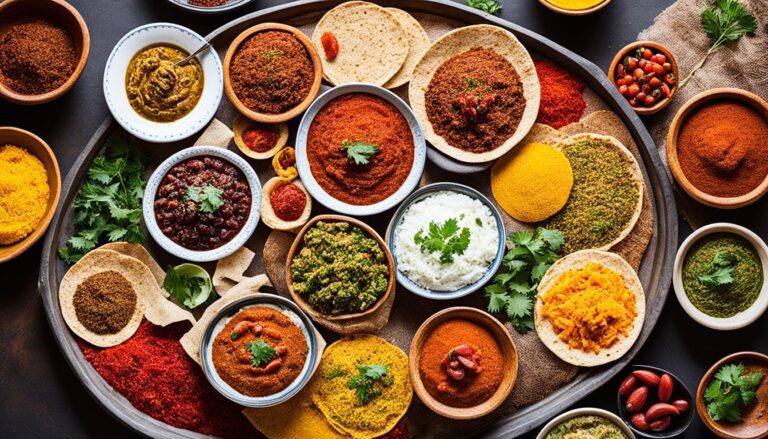How Cook Ethiopian Food?
Welcome to our culinary exploration of Ethiopian cuisine! Are you ready to embark on a flavorful journey that will transport you to the vibrant streets of Addis Ababa and awaken your taste buds to new and exotic flavors? If you’ve ever wondered how to recreate authentic Ethiopian dishes in your own kitchen, you’re in the right place. Join us as we delve into the secrets of Ethiopian cooking and unlock the delicious and aromatic world of Ethiopian cuisine.
From aromatic spices to slow-cooked stews, the rich tapestry of Ethiopian food is steeped in tradition and culture. But how exactly do they achieve those bold and tantalizing flavors? What are the essential ingredients that give Ethiopian dishes their distinct taste? And how can you master the cooking techniques that make Ethiopian cuisine so unique?
If you’re curious to learn the answers to these questions and more, then keep reading. In this article, we’ll guide you through every step of the Ethiopian cooking process. From understanding the fundamentals of Ethiopian cuisine to mastering the art of injera making, we’ll arm you with the knowledge and skills you need to become a maestro in the kitchen.
So, put on your apron and let’s get cooking! From traditional favorites like Doro Wat and Kitfo to lesser-known gems waiting to be discovered, we’ll introduce you to a world of taste sensations that will leave you craving more.
Key Takeaways:
- Embark on a flavorful journey and learn how to recreate authentic Ethiopian dishes in your own kitchen.
- Discover the essential ingredients that give Ethiopian cuisine its distinct taste.
- Master the unique cooking techniques that make Ethiopian food so special.
- Explore popular Ethiopian dishes that you can easily make at home.
- Learn expert tips and tricks for perfecting the flavors of Ethiopian cuisine.
Introduction to Ethiopian Cuisine
Before we dive into the cooking process, let’s take a moment to understand the unique characteristics of Ethiopian cuisine. Get ready to tantalize your taste buds with the diverse flavors and aromatic spices that make Ethiopian food truly special.
Known for its rich culinary heritage, Ethiopian cuisine is a delightful fusion of vibrant flavors, traditional ingredients, and ancient cooking techniques. This cuisine reflects the country’s cultural diversity and history, creating a culinary experience unlike any other.
Traditional Ethiopian dishes are often characterized by their bold and complex flavors, which are achieved through the skillful use of herbs, spices, and unique cooking methods. The cuisine showcases an array of ingredients, including legumes, grains, meat, and vegetables, resulting in a harmonious balance of textures and tastes.
One of the most iconic aspects of Ethiopian cuisine is injera, the traditional sourdough flatbread. Made from fermented teff flour, injera serves as the foundation for many dishes and is enjoyed alongside various stews, salads, and dips. The use of injera not only adds a distinctive flavor but also enhances the communal and interactive dining experience.
Another essential element of Ethiopian cuisine is the flavorful spice blend called berbere. Composed of various spices, including chili peppers, garlic, ginger, and fenugreek, berbere adds a fiery kick to dishes, infusing them with a tantalizing heat and complexity.
From the hearty and aromatic stews like Doro Wat and Tibs to the savory pancakes such as Kita Fir-Fir, each dish in Ethiopian cuisine is a culinary masterpiece that tells a story of the country’s rich heritage and cultural traditions.
So, whether you’re a seasoned food enthusiast or a curious home cook eager to explore new flavors, join us as we embark on a journey to unravel the secrets of Ethiopian cuisine. In the following sections, we will guide you through the essential ingredients, cooking techniques, popular dishes, and tips to help you master the art of Ethiopian cooking.
Essential Ingredients for Ethiopian Cooking
To master Ethiopian cuisine, you’ll need to familiarize yourself with the key ingredients used in their dishes. From berbere spice to injera bread, these are the must-have items in your pantry for authentic Ethiopian cooking.
Let’s start with berbere spice, which is a staple in Ethiopian cooking. It’s a fiery blend of chili peppers, garlic, ginger, and a variety of aromatic spices. This spice mixture adds a unique depth of flavor and a kick of heat to Ethiopian dishes.
Another essential ingredient is teff flour, the main ingredient in injera bread. Injera is a sourdough flatbread that serves as the foundation for many Ethiopian meals. Made from fermented teff flour, it has a slightly tangy taste and a spongy texture, perfect for scooping up stews and sauces.
Niter kibbeh, a spiced clarified butter, is also commonly used in Ethiopian cuisine. It’s made by simmering butter with aromatic spices such as cardamom, cinnamon, and fenugreek. Niter kibbeh adds rich flavor and aroma to dishes like doro wat, a spicy chicken stew.
Mitmita is another key ingredient you’ll find in Ethiopian cooking. It’s a blend of chili peppers, cloves, and other spices, often used to season meat dishes. Mitmita adds a fiery kick and a complex flavor profile to your dishes.
Finally, we can’t forget about injera bread itself. This traditional Ethiopian staple is made from a sourdough batter of teff flour and water. It undergoes a fermentation process that gives it a unique tangy flavor and a soft, spongy texture. Injera is not only an essential accompaniment to Ethiopian stews, but it’s also used as a utensil to scoop up food.
Now that we’ve covered some of the essential ingredients in Ethiopian cooking, you’re one step closer to mastering the art of Ethiopian cuisine. From berbere spice to injera bread, these ingredients will bring the vibrant flavors and aromatic spices of Ethiopia right into your own kitchen.
Cooking Techniques in Ethiopian Cuisine
Ethiopian cuisine is renowned for its bold and complex flavors, and the cooking techniques used in this vibrant culinary tradition are key to achieving the perfect balance of taste and texture. From slow-cooking stews to mastering the art of injera making, Ethiopian cooking methods are as diverse as the country itself.
One of the most iconic cooking techniques in Ethiopian cuisine is the Mesir Wat, a flavorful lentil stew slow-cooked with aromatic spices. The long cooking process allows the flavors to meld together, resulting in a rich and satisfying dish.
Another staple technique is the Doro Wat, a spicy chicken stew. The chicken is marinated in a blend of spices and slow-cooked until tender. This method ensures that the spices infuse the meat, creating a dish that is bursting with flavor.
When it comes to making the quintessential Ethiopian injera bread, the unique cooking technique involves fermenting a batter made from teff flour. The batter is then poured onto a hot griddle in a circular motion, creating a spongy and slightly sour flatbread that pairs perfectly with Ethiopian stews.
Mastering these cooking techniques will allow you to recreate the authentic flavors of Ethiopian cuisine in your own kitchen. So, get your spices ready, gather your ingredients, and let’s embark on a culinary journey through the diverse techniques that make Ethiopian food so special.

Popular Ethiopian Dishes You Can Make at Home
Ready to put your newfound knowledge into action? In this section, we’ll share some popular Ethiopian dishes that you can easily recreate in your own kitchen. From Doro Wat to Kitfo, get ready to impress your family and friends with these delicious creations.

If you’re looking to explore the vibrant flavors of Ethiopian cuisine, these dishes are a great place to start. Let’s dive in and discover how to prepare these mouthwatering classics.
Doro Wat
Doro Wat is one of the most beloved Ethiopian dishes. It’s a rich and aromatic chicken stew simmered in a spicy berbere sauce. The combination of tender chicken, flavorful spices, and hearty sauce creates a dish that is truly irresistible. Serve it over injera, a sourdough flatbread, for an authentic Ethiopian experience.
Kitfo
For all the meat lovers out there, Kitfo is a must-try Ethiopian delicacy. This dish features minced raw beef seasoned with spices and served with injera. The unique blend of flavors and textures makes Kitfo a real treat. If you prefer your meat cooked, you can also enjoy a version of Kitfo that’s lightly sautéed.
These are just a taste of the many incredible dishes Ethiopian cuisine has to offer. Embark on a culinary adventure and experiment with the flavors, spices, and techniques to make these popular Ethiopian dishes your own. Whether you’re hosting a dinner party or simply craving something new, cooking Ethiopian food at home is sure to impress.
Tips and Tricks for Perfecting Ethiopian Flavors
Are you ready to take your Ethiopian cooking skills to the next level? In this section, we’ve gathered some expert tips and tricks to help you perfect the flavors of Ethiopian cuisine. From balancing spices to achieving the right level of heat, these techniques will elevate your dishes and impress your taste buds.
1. Balancing Spices
One of the key elements in Ethiopian cooking is the precise balance of spices. The secret lies in combining the right proportions of each spice to create a harmonious flavor profile. Whether you’re using berbere, mitmita, or other traditional Ethiopian spice blends, start with small amounts and gradually adjust according to your taste preferences. Remember, a little goes a long way!
2. Understanding Heat Levels
Spicy heat is another defining characteristic of Ethiopian cuisine. To achieve the perfect level of heat in your dishes, it’s important to understand the various pepper types used in Ethiopian cooking. From mild jalapeños to fiery bird’s eye chilies, choose and combine peppers according to your tolerance and desired spiciness. Don’t forget to remove the seeds for a milder flavor!
3. Developing Deep Flavors
Many Ethiopian dishes are known for their complex and deeply flavorful profiles. To enhance the depth of flavor in your cooking, consider slow-cooking stews and sauces to allow the ingredients to develop richness over time. Additionally, using quality ingredients, such as homemade stock and freshly ground spices, will elevate your dishes to new heights.
These tips and tricks are just the beginning of perfecting Ethiopian flavors. Don’t be afraid to experiment, try new combinations, and make the recipes your own. With practice and a little bit of flair, you’ll become a master of Ethiopian cuisine in no time.
Continue reading as we explore some popular Ethiopian dishes that you can easily recreate in your own kitchen in the next section.
Conclusion
As we wrap up our culinary journey through Ethiopian cuisine, we hope you now feel confident in your ability to cook delicious Ethiopian dishes at home. The rich and flavorful traditions of Ethiopian cuisine provide a unique experience for your taste buds, and now you have the knowledge and skills to recreate these exotic flavors in your own kitchen.
Embrace the diverse and vibrant world of Ethiopian food by experimenting with different recipes. Whether it’s the iconic Doro Wat, a flavorful injera bread, or the mouthwatering Kitfo, there’s something for everyone to enjoy. Each dish tells a story and showcases the rich cultural heritage of Ethiopia.
Remember to embrace the flavors of Ethiopian cuisine by incorporating the essential ingredients, such as the aromatic berbere spice and the tangy injera bread. These ingredients are the heart and soul of Ethiopian cooking and will help you achieve that authentic taste.
So go ahead, embark on your own culinary adventure and explore the beauty of Ethiopian cuisine. With our guide and your creativity, you can bring a taste of Ethiopia into your home and share these delightful flavors with your loved ones. Enjoy the journey and savor the deliciousness of Ethiopian food!







